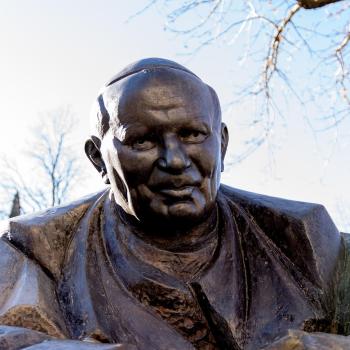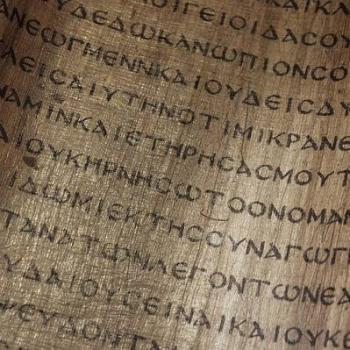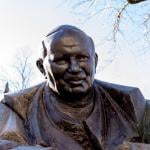THE RELIGION GUY OBSERVES that with “fake news” all over the news it’s wise to be aware of fake history. Consider Dan Brown’s influential pop novel “The Da Vinci Code.” Though the plot is fiction, readers may assume the book provides reliable historical background. Experts say that’s misleading, and one example is Brown’s version of how the New Testament came to be.
That’s a timely question due to an important new technical work on the subject, “The Biblical Canon Lists from Early Christianity” by Edmon Gallagher and John Meade. “Canon” refers to recognized Scriptures. Oxford University Press published this collection of ancient texts and analysis in Britain this month, with U.S. release due in January.
(The following relies on “The Formation of the New Testament” (1965) by Robert M. Grant of the University of Chicago, and “The Canon of the New Testament” (1987) by Bruce M. Metzger of Princeton Theological Seminary, and covers only the New Testament, not the canon of the Hebrew Bible a.k.a. Old Testament.)
Brown is correct that many texts about Jesus were circulating during Christianity’s first few centuries, so decisions had to be made about which were authentic and recognized as Scripture. Many Christian folk don’t realize how complex the process was.
By Brown’s account, the Roman Emperor Constantine was the power-broker who picked only Matthew, Mark, Luke and John out of some 80 Gospels in contention. Actually what Constantine did in A.D. 331 was commission Bishop Eusebius to have copyists produce 50 new copies of the Greek canon to replace Scriptures that had been destroyed during Rome’s previous anti-Christian purge. The 80 count is exaggerated, and most rejected writings did not resemble the genre of the favored four, which were not chosen by the emperor but church authorities.
Brown also says the decision-maker was religiously “pagan.” Actually, Constantine was drawn to Christianity as early as his imperial edict in 312 that ended persecution and allowed Christians to worship openly. He was only officially baptized as a Christian on his deathbed in 337, but such delays by believers were common in those times.
The list of 27 books in the New Testament we know was actually ratified a bit later, in the 367 Easter letter of Egypt’s Bishop Athanasius, by the Council of Rome (382) and the Council of Carthage (397), though some holdouts continued to reject this or that book.
That’s not to imply the canon only popped up in the 4th Century. The accepted list of books was largely settled two centuries earlier. Grant records that “in general 2nd Century Christians regarded as authoritative four Gospels, 13 Pauline epistles, 1 Peter, 1 John, and Revelation (sometimes also the book of Acts).” There was uncertainty whether six other epistles belonged.
There’s special interest in the “Muratorian” canon list from around A.D. 170 (rediscovered and published in 1740). It shows by that time the church accepted four Gospels ( Matthew and Mark are not named because the damaged manuscript begins mid-sentence). Also listed were Acts, the 13 letters attributed to Paul, Revelation, Jude’s letter, and two letters of John (omitting Hebrews, James, 1 and 2 Peter, and a John letter). The fragment notes disagreement over the Apocalypse of Peter, says the Shepherd of Hermas is acceptable for private use but not in church, and rejects a number of writings as spurious.
Now, what criteria did ancient church leaders use in deciding what to include and exclude? Three tests were central. First, did the substance fit with the tradition the church had received? Second, could traditions about a text be traced back to “apostolic” origins? Third, was a book accepted and used by much of Christendom for a long time, as opposed to recent or local accceptance?
Well beyond biblical times there were proposals to rethink the defined canon. Martin Luther, much in the news with this autumn’s 500th Reformation anniversary, downgraded James, Jude, Hebrews, and Revelation, while fellow Reformer Ulrich Zwingli rejected the latter book.
What about adding instead of subtracting books? Modern writers who find the New Testament too narrow have popularized dozens of texts rediscovered at Nag Hammadi, Egypt, in 1945. These manuscripts in the Coptic language date from the 4th Century but translated Greek originals from earlier times. Many express “Gnostic” religions that were spurned by orthodox Christianity due to lack of apostolic roots, elitism, secrecy, fanciful anecdotes, or emphasis on Jesus’ divinity with aversion to his real humanity.
Metzger, a judicious conservative, thought there might be some authentic material in one such text known as the Gospel of Thomas. Note its concluding teaching attributed to Jesus: “I will guide her to make her male, so that she too may become a living spirit resembling you males. For every female who makes herself male will enter the kingdom of Heaven.”
In Metzger’s view, scholarly analysis of the Nag Hammadi and other literature underscores that no ancient books “may be compared with the New Testament,” which “contains the best sources for the history of Jesus.”












